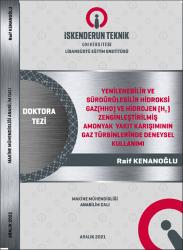| dc.contributor.advisor | Baltacıoğlu, Ertuğrul | |
| dc.contributor.author | Kenanoğlu, Raif | |
| dc.date.accessioned | 2022-10-13T13:18:28Z | |
| dc.date.available | 2022-10-13T13:18:28Z | |
| dc.date.issued | 2021 | en_US |
| dc.identifier.citation | Kenanoğlu, R. (2021). Yenilenebilir ve sürdürülebilir hidroksi gaz (HHO) ve hidrojen (H2) zenginleştirilmiş amonyak yakıt karışımının gaz türbinlerinde deneysel kullanımı (Doktora Tezi). İskenderun Teknik Üniversitesi / Lisansüstü Eğitim Enstitüsü / Makine Mühendisliği Ana Bilim Dalı | en_US |
| dc.identifier.uri | https://hdl.handle.net/20.500.12508/2163 | |
| dc.description.abstract | Enerji, günümüzün ve geleceğimizin en önemli ihtiyacıdır ve hidrojen, temiz enerji çözümünün ve hatta temiz geleceğin anahtarıdır. Günümüzde, enerji üretim uygulamalarında (içten yanmalı motorlar ve yakıt hücreleri) hidrojen kullanımının önemli zorlukları, nakliye ve depolama olarak bilinmekte ve bunlar, uygulama güvenliği konusunda büyük bir tereddüt yaratmaktadır. Hidrojen uygulamalarındaki bu problemleri çözmek için en umut verici alternatif olan amonyak, düşük basınçlarda ve yüksek sıcaklıklarda sıvı halde depolama imkanı sağlar. Çalışmada amonyak üretim süreçlerinden detaylı olarak bahsedilmemekle birlikte güneş enerjisi kullanılarak elde edilen hidroksi gazın temiz üretimi anlatılmıştır. Bu çalışma, bir gaz türbininde ana yakıt olarak amonyak kullanmanın dezavantajlarının hidrojen ve hidroksi-gaz zenginleştirmesi ile nasıl telafi edileceğini araştırmak için yapılmıştır. Deneyler sırasında, gaz türbininin standart çalışma yakıtı olan propan, saf amonyak ve 3 L / dak, 5 L / dak ve 7 L / dak hidroksi gazı ile zenginleştirilmiş sabit 10 L / dak amonyak yakıtı ve 3 L / dak, 5 L / dak ve 7 L / dak H2 kullanıldı. Deneylerde kullanılan gaz türbininde propan ile yapılan çalışmalarda elde edilen performans çıktıları H2 ve HHO ile zenginleştirilmiş amonyak çıktıları ile karşılaştırılmıştır. Bu karşılaştırmalar sırasında hacimce yakıt zenginleştirmeleri kategorilere ayrılmış ve daha sonra her yakıt zenginleştirme türü için ayrı ayrı karşılaştırmalar yapılmıştır. Sonuçlar, hidroksi gas zenginleştirmelerinin performans verilerinde ve herhangi bir karbon emisyonunun olmaması nedeniyle emisyon değerlerinde iyileştirmelere neden olduğunu göstermektedir. Performans ve karbon emisyonlarındaki iyileştirmelerin yanı sıra önemli olan konu NOx emisyonlarının kontrol altında tutulması gerektiğidir. Filtre kullanılmamasına rağmen literatürde bu NOx ve yanmamış NH3 emisyonlarının Seçici Katalizör İndirgeme (SCR) kullanılarak önlenebileceği bildirilmiştir. | en_US |
| dc.description.abstract | Energy is the most crucial need of our present and future, and hydrogen is the key to clean energy solution and even to the clean future. Today, the important challenges of utilization hydrogen in power-producing applications (internal combustion engines and fuel cells) are known as transportation and storage and these create a big hesitation regarding application safety. Ammonia, which is the most promising alternative to solve those problems of hydrogen applications, provides the possibility of storage in liquid form at low pressures and high temperatures. Although the ammonia production processes were not mentioned in detail in the study, the clean production of the hydroxy gas obtained by using solar energy was explained. This study was carried out to investigate how to compensate the drawbacks of using ammonia as the main fuel in a gas turbine by hydrogen and hydroxy-gas enrichment. During the experiments, propane that is standard working fuel of the gas turbine, neat ammonia, as well as a constant 10 L/min ammonia fuel enriched with 3 L/min, 5 L/min, and 7 L/min hydroxy gas and 3 L/min, 5 L/min, and 7 L/min H2 were utilized. The performance outputs obtained in the studies with propane in the gas turbine used in the experiments were compared with the ammonia outputs enriched with H2 and HHO. During these comparisons, fuel enrichments by volume were categorized and then separate comparisons were made for each fuel enrichment type. The results show that hydroxy gas enrichments lead to improvements in performance data and emission values due to the absence of any carbon emissions. Besides the improvements in performance and carbon emissions, the important issue is that NOx emissions should be kept under control. Although no filter is used, it has been reported in the literature that these NOx and unburned NH3 emissions can be prevented by using Selective Catalyst Reduction (SCR). | en_US |
| dc.language.iso | tur | en_US |
| dc.publisher | İskenderun Teknik Üniversitesi / Lisansüstü Eğitim Enstitüsü / Makine Mühendisliği Ana Bilim Dalı | en_US |
| dc.rights | info:eu-repo/semantics/openAccess | en_US |
| dc.subject | Amonyak | en_US |
| dc.subject | HHO | en_US |
| dc.subject | Gaz türbin | en_US |
| dc.subject | Performans | en_US |
| dc.subject | Hidrojen | en_US |
| dc.subject | Ammonia | en_US |
| dc.subject | Gas turbine | en_US |
| dc.subject | Performance | en_US |
| dc.subject | Hydrogen | en_US |
| dc.title | Yenilenebilir ve sürdürülebilir hidroksi gaz (HHO) ve hidrojen (H2) zenginleştirilmiş amonyak yakıt karışımının gaz türbinlerinde deneysel kullanımı | en_US |
| dc.title.alternative | Experimental use of renewable and sustainable hydroxy gas (HHO) and hydrogen (H2) enhanced ammonia fuel mixture in gas turbines | en_US |
| dc.type | doctoralThesis | en_US |
| dc.contributor.department | Mühendislik ve Doğa Bilimleri Fakültesi | en_US |
| dc.identifier.startpage | İV | en_US |
| dc.identifier.endpage | 91 | en_US |
| dc.relation.publicationcategory | Tez | en_US |
| dc.contributor.isteauthor | Kenanoğlu, Raif | |
| dc.contributor.isteauthor | Baltacıoğlu, Ertuğrul | |
| dc.relation.index | İndeks Bilgisi Yok | en_US |
















